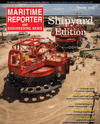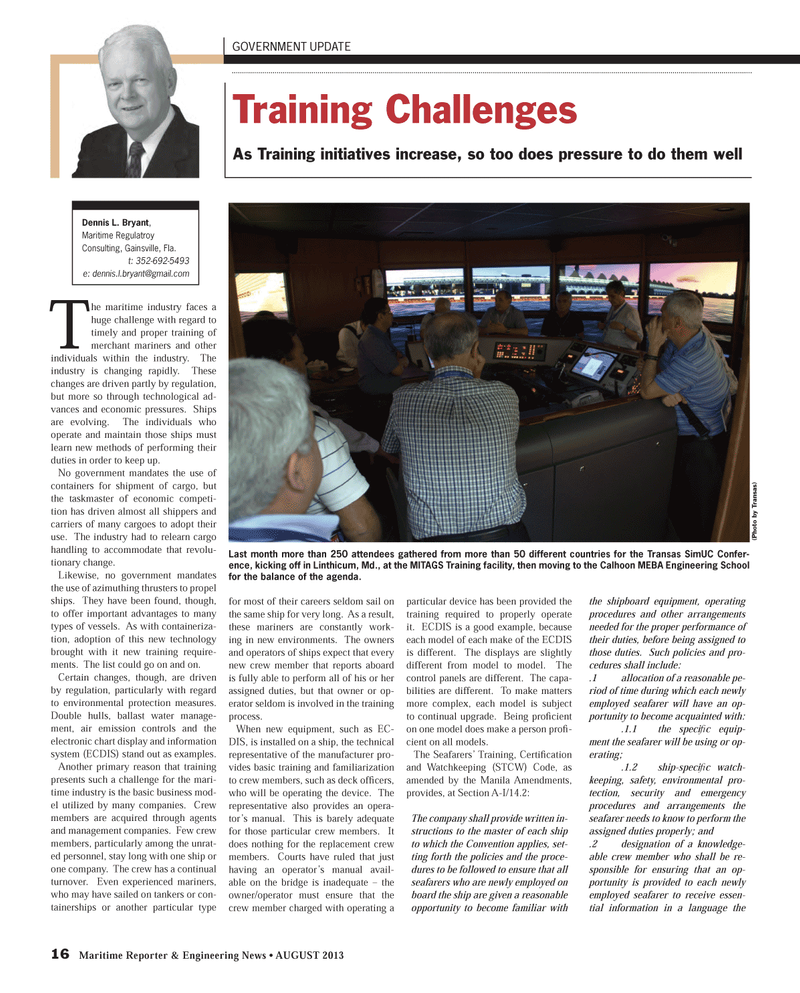
Page 16: of Maritime Reporter Magazine (August 2013)
Shipyard Edition
Read this page in Pdf, Flash or Html5 edition of August 2013 Maritime Reporter Magazine
16 Maritime Reporter & Engineering News ? AUGUST 2013 GOVERNMENT UPDATE Training Challenges As Training initiatives increase, so too does pressure to do them well The maritime industry faces a huge challenge with regard to timely and proper training of merchant mariners and other individuals within the industry. The industry is changing rapidly. These changes are driven partly by regulation, but more so through technological ad-vances and economic pressures. Ships are evolving. The individuals who operate and maintain those ships must learn new methods of performing their duties in order to keep up.No government mandates the use of containers for shipment of cargo, but the taskmaster of economic competi-tion has driven almost all shippers and carriers of many cargoes to adopt their use. The industry had to relearn cargo handling to accommodate that revolu-tionary change.Likewise, no government mandates the use of azimuthing thrusters to propel ships. They have been found, though, to offer important advantages to many types of vessels. As with containeriza- tion, adoption of this new technology brought with it new training require-ments. The list could go on and on. Certain changes, though, are driven by regulation, particularly with regard to environmental protection measures. Double hulls, ballast water manage-ment, air emission controls and the electronic chart display and information system (ECDIS) stand out as examples.Another primary reason that training presents such a challenge for the mari-time industry is the basic business mod-el utilized by many companies. Crew members are acquired through agents and management companies. Few crew members, particularly among the unrat-ed personnel, stay long with one ship or one company. The crew has a continual turnover. Even experienced mariners, who may have sailed on tankers or con-tainerships or another particular type for most of their careers seldom sail on the same ship for very long. As a result, these mariners are constantly work-ing in new environments. The owners and operators of ships expect that every new crew member that reports aboard is fully able to perform all of his or her assigned duties, but that owner or op-erator seldom is involved in the training process.When new equipment, such as EC-DIS, is installed on a ship, the technical representative of the manufacturer pro-vides basic training and familiarization to crew members, such as deck ofÞ cers, who will be operating the device. The representative also provides an opera-tor?s manual. This is barely adequate for those particular crew members. It does nothing for the replacement crew members. Courts have ruled that just having an operator?s manual avail- able on the bridge is inadequate ? the owner/operator must ensure that the crew member charged with operating a particular device has been provided the training required to properly operate it. ECDIS is a good example, because each model of each make of the ECDIS is different. The displays are slightly different from model to model. The control panels are different. The capa- bilities are different. To make matters more complex, each model is subject to continual upgrade. Being proÞ cient on one model does make a person proÞ -cient on all models.The Seafarers? Training, Certi Þ cation and Watchkeeping (STCW) Code, as amended by the Manila Amendments, provides, at Section A-I/14.2: The company shall provide written in- structions to the master of each ship to which the Convention applies, set-ting forth the policies and the proce- dures to be followed to ensure that all seafarers who are newly employed on board the ship are given a reasonable opportunity to become familiar with the shipboard equipment, operating procedures and other arrangements needed for the proper performance of their duties, before being assigned to those duties. Such policies and pro- cedures shall include: .1 allocation of a reasonable pe- riod of time during which each newly employed seafarer will have an op- portunity to become acquainted with: .1.1 the speci Þ c equip- ment the seafarer will be using or op- erating; .1.2 ship-speci Þ c watch- keeping, safety, environmental pro- tection, security and emergency procedures and arrangements the seafarer needs to know to perform the assigned duties properly; and .2 designation of a knowledge- able crew member who shall be re- sponsible for ensuring that an op-portunity is provided to each newly employed seafarer to receive essen- tial information in a language the Dennis L. Bryant, Maritime Regulatroy Consulting, Gainsville, Fla.t: 352-692-5493e: [email protected] month more than 250 attendees gathered from more than 50 different countries for the Transas SimUC Confer- ence, kicking off in Linthicum, Md., at the MITAGS Training facility, then moving to the Calhoon MEBA Engineering School for the balance of the agenda. (Photo by Transas) MR #8 (10-17).indd 16MR #8 (10-17).indd 168/1/2013 9:03:59 AM8/1/2013 9:03:59 AM

 15
15

 17
17
